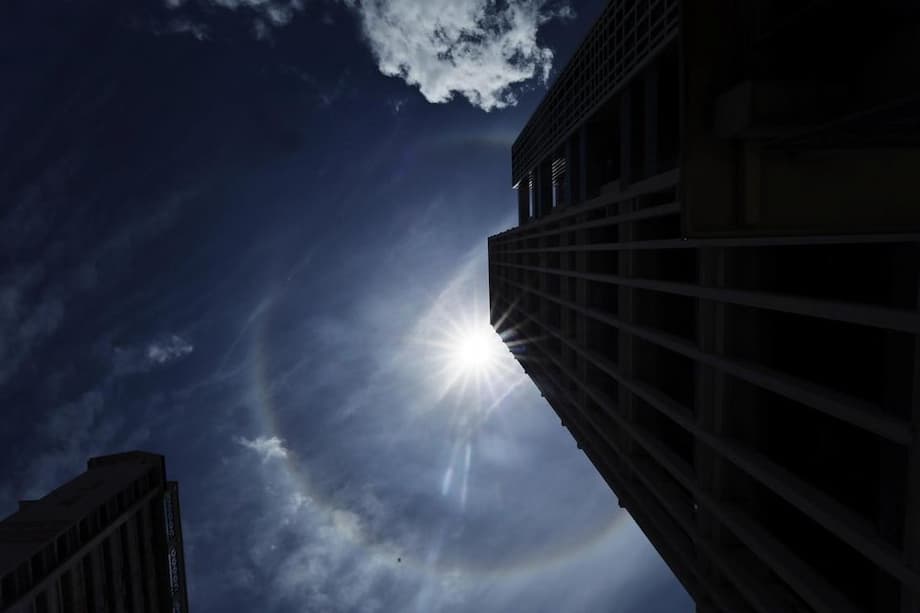Singapore’s Sky Stuns with Rare Sun Halo
On August 25, 2025, Singaporeans looked up to a midday sky transformed by a spectacular natural phenomenon: a luminous ring of light encircling the sun, known as a sun halo. The event, visible across the island from late morning through early afternoon, captivated residents and sparked a flurry of photographs and social media posts. For many, it was a first-time encounter with this rare optical marvel, and the excitement was palpable both online and on the streets.
- Singapore’s Sky Stuns with Rare Sun Halo
- What Is a Sun Halo and How Does It Form?
- Public Reaction: Awe, Excitement, and a Social Media Frenzy
- Why Are Sun Halos So Rare in Singapore?
- Safety First: Enjoying the Halo Without Risk
- Community Engagement: From Eyewitness Accounts to Viral Photos
- Scientific and Meteorological Insights
- Historical Context: Previous Sun Halos in Singapore
- Why Do We Find Sun Halos So Fascinating?
- In Summary
Sun halos are not only visually stunning but also scientifically fascinating. Their appearance in Singapore—a city-state more accustomed to tropical downpours than icy sky spectacles—underscores both the unpredictability and the wonder of nature.
What Is a Sun Halo and How Does It Form?
A sun halo is an optical phenomenon that appears as a bright, circular ring around the sun. The most common type, the 22-degree halo, forms when sunlight passes through millions of tiny ice crystals suspended high in the atmosphere, typically within thin cirrus clouds. These crystals act like miniature prisms, bending (refracting) the light by about 22 degrees, which creates the distinctive ring.
Professor Matthias Roth, a geography expert at the National University of Singapore, explained the science behind the spectacle:
As light enters one face of the ice crystals and exits through another, it is bent by about 22 degrees, which accounts for the radius of the halo.
Unlike rainbows, which are formed by water droplets and are often seen after rain, sun halos require ice crystals. These crystals are found in clouds at altitudes above 5,000 meters, where temperatures are low enough for ice to form even in tropical regions. The specific orientation and uniform shape of these crystals are crucial for producing a well-defined halo.
Singapore’s warm, humid climate rarely produces the high-altitude, ice-filled cirrus clouds necessary for sun halos. Most of the time, the sky is dominated by lower, water-laden clouds that obscure such phenomena. This makes any sighting of a sun halo in Singapore a noteworthy event.
Public Reaction: Awe, Excitement, and a Social Media Frenzy
As the halo appeared around noon, residents from Clementi to Paya Lebar, Pasir Panjang, and North Bridge Road paused their routines to gaze skyward. Many quickly reached for their phones, capturing the moment and sharing it across platforms like Facebook, TikTok, Reddit, and Instagram. The hashtag #sunhalo trended locally as images and videos spread rapidly.
One TikTok user advised,
Don’t miss it, guys. Go out and watch it with protected sunglasses.
Another Facebook group post simply read,
Happening now!
urging others to step outside and witness the rare event.
For some, the experience was deeply personal. Natalie Neo, working from home at Farrer Road, described her first encounter with a sun halo as a blessing. Ow Yong Weng Leong, who noticed the halo while in town, shared that it was an emotional moment, reminding him of his grandmother. Such reactions highlight the power of natural phenomena to evoke wonder and nostalgia.
Passers-by in Clementi were seen taking photos, and even Senior Minister Lee Hsien Loong joined in, sharing his own snapshot of a previous sun halo on social media and calling it a “rare and spectacular sight.” The communal excitement was further amplified by news outlets and photography enthusiasts, who documented the event from multiple vantage points across the island.
Why Are Sun Halos So Rare in Singapore?
Despite their beauty, sun halos are infrequent in Singapore. The National Environment Agency (NEA) explains that the country’s typical cloud cover—dominated by low to mid-level clouds—usually blocks the high-altitude cirrus clouds needed for halos to form. Even when these clouds are present, the precise arrangement of ice crystals required for a halo is difficult to predict.
According to NEA,
Sun halos are not common in Singapore as they are usually covered by low to mid-level clouds. It is difficult to forecast the precise location of these ice crystals in the atmosphere, which determines where the halo can be seen.
Historical records show that sun halos have appeared in Singapore only a handful of times in recent years. Prior to the August 2025 event, the last sighting was on March 15, 2025, with earlier occurrences in September 2020 and sporadically in the years before. Each appearance is met with widespread fascination, as residents recognize the rarity of the event.
Safety First: Enjoying the Halo Without Risk
While the halo itself is safe to observe with the naked eye, experts and authorities consistently warn against looking directly at the sun. The NEA and other agencies emphasize that doing so—even briefly—can cause permanent eye damage. Sunglasses or solar viewing glasses are recommended for those hoping to enjoy the spectacle safely.
One TikTok user’s advice to wear sunglasses was echoed by official statements. The NEA has previously stated,
It will be dangerous to look at the sun directly without proper protection.
This message was widely shared alongside images of the halo, helping to ensure that public enthusiasm did not come at the expense of eye health.
Community Engagement: From Eyewitness Accounts to Viral Photos
The August 25 sun halo became a shared experience for Singaporeans of all ages. Social media platforms were flooded with photos taken from diverse locations—Changi General Hospital, Clementi, Bedok, Serangoon Gardens, Woodlands, and more. Some users even reported sightings in neighboring Malaysia, underscoring the regional reach of the phenomenon.
On Reddit, a striking image captured at Changi General Hospital drew admiration and sparked discussion about the science behind halos. The Photographic Society of Singapore’s Facebook page saw a surge in activity, with members posting real-time updates and encouraging others to look up. The event also featured in local news outlets’ “Today in Pictures” segments, further cementing its status as a memorable moment in Singapore’s collective consciousness.
Such widespread engagement highlights the role of social media in bringing people together around shared experiences—especially those that are rare and visually striking. The sun halo not only inspired awe but also fostered a sense of community, as residents swapped stories, tips, and images.
Scientific and Meteorological Insights
Sun halos are a well-documented atmospheric phenomenon, but their occurrence in tropical regions like Singapore is a reminder of the complexity and variability of weather patterns. The formation of a halo depends on several factors:
- Presence of high-altitude cirrus clouds containing ice crystals
- Clear skies at lower altitudes to allow sunlight to reach the crystals
- Specific orientation and uniformity of the ice crystals
These conditions are more common in temperate or polar regions, where cold upper-atmosphere temperatures are the norm. In Singapore, such conditions are fleeting, often occurring when high-level clouds are blown in from surrounding areas under favorable wind patterns.
The 22-degree halo is the most frequently observed type, but other, rarer halos can form under different crystal shapes and orientations. Occasionally, halos may display faint colors, resembling a rainbow, due to the dispersion of light. However, the August 25 event was primarily noted for its bright, white ring.
According to meteorologists, the unpredictability of these events adds to their allure. As the NEA notes, forecasting the presence and position of the necessary ice crystals is extremely challenging, making each sun halo a delightful surprise.
Historical Context: Previous Sun Halos in Singapore
The August 2025 sun halo was the second such event recorded in Singapore that year, following a similar sighting on March 15. On that occasion, the halo was visible from locations including Chinese Garden, Serangoon Gardens, Bedok, and Woodlands, with sightings reported between 11am and 3pm. Senior Minister Lee Hsien Loong’s social media post about the March event helped raise public awareness and encouraged others to share their own photos.
Earlier sun halos were documented in September 2020 and sporadically in the years before. Each event has been met with widespread excitement, with residents eager to capture and share the fleeting beauty. The rarity of sun halos in Singapore ensures that every appearance becomes a minor cultural event, celebrated both online and offline.
Why Do We Find Sun Halos So Fascinating?
Natural phenomena like sun halos captivate us for several reasons. Their rarity in certain regions, combined with their striking visual impact, makes them memorable. The science behind halos—light bending through ice crystals high above—adds a layer of intrigue, connecting everyday experience with the mysteries of the atmosphere.
For many, witnessing a sun halo is a reminder to pause and appreciate the world around us. As one resident put it,
It was a blessing to see something so beautiful in the middle of an ordinary day.
Such moments can inspire curiosity about science, foster community spirit, and provide a welcome break from routine.
In Summary
- On August 25, 2025, Singaporeans witnessed a rare sun halo, sparking widespread excitement and social media sharing.
- Sun halos form when sunlight refracts through ice crystals in high-altitude cirrus clouds, creating a 22-degree ring around the sun.
- The phenomenon is uncommon in Singapore due to the prevalence of low to mid-level clouds and the city’s tropical climate.
- Experts and authorities remind the public to avoid looking directly at the sun, even when observing a halo.
- Community engagement was high, with residents sharing photos, stories, and safety tips across multiple platforms.
- Previous sun halos in Singapore were recorded in March 2025 and September 2020, highlighting the rarity of the event.
- The August 25 sun halo served as a reminder of nature’s beauty and unpredictability, inspiring awe and curiosity among all who witnessed it.












